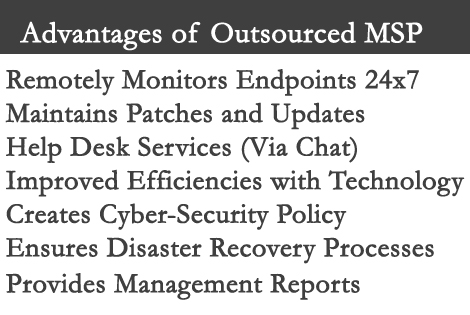What are the advantages of having an outsourced Managed IT Service Provider?
What are the advantages of having an outsourced managed IT service provider in the Atlanta metro area? Just like large organizations use technology to run their operations, email clients, and manage their financials, small businesses do the same. Despite how the technology industry is simplifying IT with cloud computing and services, with so many components, technology infrastructure still needs to be managed and monitored 24x7.
Successful businesses will often use standardized operating procedures (SOPs) and Key Performance Indicators to monitor the processes that create value for their customers. However, these same businesses will often lack SOPs or metrics for their IT infrastructure. In essence, they are not managing their IT systems and lack a plan of action. And just like the adage says, “a failure to plan, is a plan to fail.” These companies will experience either a minor or a catastrophic IT failure at some point.
What are the costs of an IT failure?
There are several cost to include when considering the impact of an IT failure for small businesses. While some of these costs will have direct monetary impact, others are more intangible. The nature of the IT system failure will determine the specific cost. For example, if a ransomware attack is successful on a business, then the initial cost could be a loss of productivity. However, it can quickly cascade into lost revenue since employees will be unable to work, and lost data since most ransomwares do not unlock the computers once the ransom is paid. Additionally, there will be a cost for a technician to use safe backups (if there are back-ups) to restore computers or outfit a new platform, employees could become frustrated and the company’s morale could deteriorate, and your brand may suffer irreparable damage. With all the costs associated with IT failures, businesses cannot leave their IT systems to chance.
What are the chances of an IT failure?
Similar to the cost of IT system failure, the chances of a failure depend on the cause of the failure. Siting the global Wanna Cry Ransomware attacks that occurred in May 2017 as an example to illustrate the chances and likelihood of a failure it will become apparent that failures can be minimized if IT systems are managed. The Wanna Cry ransomware attack affected over 200,000 computers in 150 countries.On March 14th, 2017 Microsoft released a security bulletin and patch to protect against the Wanna Cry virus. However, the virus attack was not until May 12th, 2017. What this demonstrates is that unless your system is actively being managed, then IT systems are at risk of failure. Ultimately the creators of the virus only received $140,000 in bitcoin and are estimated to have caused $4billion in losses.
Although solutions were found to address Wanna Cry ransomware, A new variation of Wanna Cry ransomware caused Taiwan Semiconductor Manufacturing Company (TSMC) to temporarily shut down several of its factories in August 2018.
With new cyber-security threats, software updates, patch releases routinely be updated, conflicts within IT systems that need to be managed by a person familiar with a company’s business.
How are IT failures avoided?
Small businesses often do not take the proper precautions to avoid IT failures for a variety of reasons. For one, the salary of an internal IT technician can cost anywhere from $60,000 to $90,000 a year. For a small business, this can be a prohibitive cost barrier. Furthermore, most small businesses do not have the need for full-time IT service technician. Therefore, they either attempt to manage it themselves or may hire an individual on a break and fix model. When “fixing” IT systems themselves, the task usually falls on the shoulders of an employee who is not qualified and perceives the responsibility as a burden beyond their job description. The maintenance is neglected, and the employee corrects issues inefficiently, gets behind on their primary duties and suffers from reduced morale.
A tempting alternative is to hire an outside IT service technician to fix problems as they arise. However, this option often lacks accountability, transparency, and managed processes. Additionally, if your business experiences an IT service issue simultaneously as another site, then the IT service technician will not be able to respond to your needs.
In order for any organization to reduce their risk of an IT system failure, processes and metrics need to be put into place. By partnering with a Managed Service Provider (MSP) that specializes in supporting small to medium size business, a company can have a virtual CIO / CTO to implement processes that will reduce the risk of IT system failures. This IT service often includes, Help Desk availability, 24x7 monitoring, patch maintenance, cyber-security solutions, cloud migration, cloud services, data back-up, and disaster recovery plans.
Moreover, a small business would no longer be reliant or held hostage by an individual IT service technician. A good MSP will not only create SOPs to manage the IT systems of its customers, but it will also provide them with easy to understand reports so as to be held accountable by their clients.
In conclusion…
IT systems are becoming streamlined and more efficient. However, that does not mean their performance and reliability does not erode over time. However, the potential cost of IT system failures is far greater than the cost for managed IT Systems. Furthermore, relying exclusively on IT service technician does not guarantee proactive management of a company’s IT infrastructure. In order for a small business to have confidence in their IT systems while keeping their cost minimal, the solution is an MSP who remotely monitors endpoints 24x7, maintains patches and updates, provides Help Desk Services (via chat, phone, email), proactively seeks to improve client’s efficiencies with technology recommendations, provides plans for cyber-security and data-back up, and provides easy to understand reports for their clients.



